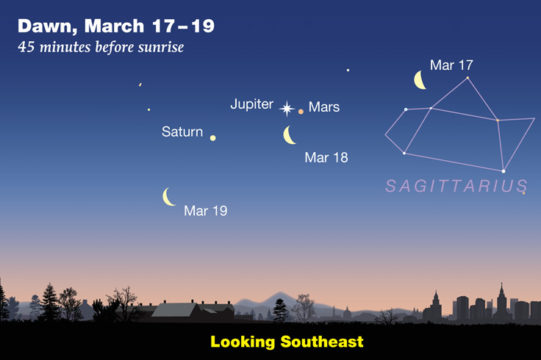During March, the cosmos offers a lot to see both before sunrise and after sunset.

Listen Here:
Podcast: Play in new window | Download
Subscribe: Apple Podcasts | Google Podcasts | Spotify | Email | RSS | More

Sky & Telescope
Early risers can easily spot Mars, Jupiter, and Saturn in the predawn sky. They're three bright beacons above the southeastern horizon. But their arrangement changes over the next few weeks. To figure out which one is which, listen to this month's Sky Tour!
Meanwhile, Venus, is the dramatically bright "Evening Star" high in the southwestern sky after sunset. It's not a star, of course, but Venus looks so bright because lots of sunlight is reflecting off the planet's nearly pure-white cloudtops.
Looking south after sunset, you'll spot Sirius — the brightest actual star in the nighttime sky. It's only 8½ light-years away. Maybe you've heard Sirius called the Dog Star — have you ever wondered how it got that name? (Hint: Listen to this month's Sky Tour for the answer!)
If your sky is especially dark and free of light pollution, or if you can get to someplace where it is, you can also look for a treat called the zodiacal light. This is a diffuse cone or wedge of soft light that tapers to a point as it extends upward and to the left from the western horizon after twilight ends. Late March is a good time to look because the cone of light stands most upright and there’s no interference from moonlight.
Play or download this month's Sky Tour to get a fun and informative guided tour of the nighttime sky!
 0
0
Comments
You must be logged in to post a comment.